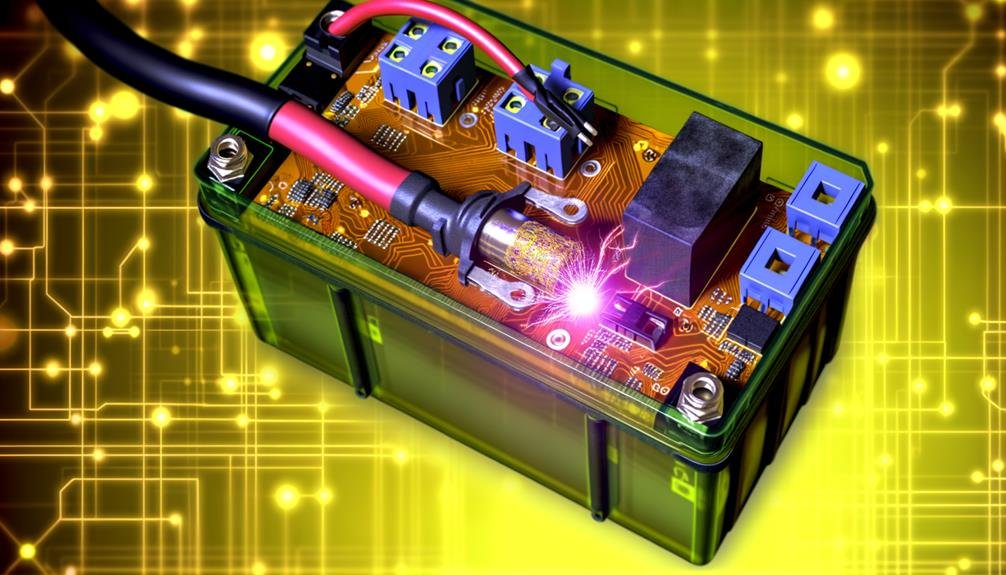Charles Miller is a veteran bike enthusiast with over 12 years of experience dealing with bikes as a mechanic. Despite immense love and expertise for...
The functionality of electric bike batteries and their associated components can be a complex topic, yet intriguingly significant. One such component, the fuse, plays an essential role in maintaining the electrical integrity of these batteries.
Fuses function as the gatekeepers to the battery's health, protecting it from potential electrical overloads. Now, one might question the presence of fuses in all e-bike batteries, their role, and their impact on the bike's overall performance.
Thus, it is indeed fruitful to examine this aspect further, which could potentially unveil valuable insights into the effective maintenance and longevity of electric bike batteries.
Key Takeaways
- Electric bike batteries are equipped with internal fuses for protection.
- The Battery Management System (BMS) controls the input and output of power and uses high-power switching transistors to disconnect the output during overload.
- Some electric bike batteries have two fuses, one in the charging circuit and another on the supply side.
- Understanding the technical aspects and maintenance of fuses is essential for the longevity and safety of the electrical system.
Understanding Electric Bike Batteries
To comprehend the intricacies of electric bike batteries, it is essential to note that these batteries are equipped with internal fuses for protection, with some featuring two fuses in the charging and supply circuits. This redundancy in safety measures ensures that your electric bike performs optimally, safeguarding you against potential electrical malfunctions.
The heart of understanding electric bike batteries lies in the Battery Management System (BMS). This critical component controls the input and output of power, employing high-power switching transistors to disconnect the output in case of an overload. Once the fault is removed, the BMS resets the battery fuse, restoring normal functionality.
Also central to the operation of electric bikes is the controller, which regulates reverse power connection, under-voltage, and over-current load. Certain advanced models even cut off the battery connection in case of reverse power flow, adding an extra layer of security.
To troubleshoot power failures effectively, it is crucial to understand these electrical connections and their purpose. Regular checks of the connections and employing proper precautions can prevent accidents and damage, especially those related to reverse polarity.
The key, therefore, to understanding electric bike batteries, lies in an appreciation of its complex yet elegantly designed safety mechanisms.
The Role of Fuses in E-bikes
E-bike fuses play a crucial role in maintaining the integrity of the electrical system by breaking the circuit in the event of a fault, thereby preventing damage to the battery and other components.
The technical understanding of these fuses, along with their maintenance, is essential for the longevity of the E-bike's electrical system. This includes regular checks of connections and following safety protocols when handling these electric bikes.
Understanding E-bike Fuses
In the realm of electric bikes, internal fuses serve a vital role in safeguarding the battery system against faults and overloads. These fuses, often located inside the frame, provide protection against potential electrical mishaps.
Understanding e-bike fuses necessitates a grasp of their dual protective role. Some batteries boast two fuses, one on the charging circuit and another on the supply side, offering comprehensive safety. The Battery Management System (BMS) incorporates high-power switching transistors, disconnecting the output during overload situations and resetting the fuse once the fault is removed.
Fuse Maintenance in E-bikes
Delving into the subject of fuse maintenance in electric bikes, it is crucial to note that the fuses embedded within the battery system play a significant role in ensuring the safety and proper functioning of the e-bike.
The battery management system utilizes high power Mosfets to disconnect the output during overload, effectively resetting the fuse once the fault is rectified. Controllers vigilantly manage reverse power connection, under voltage, and over current load, even going to the extent of cutting off the battery connection under reverse power flow.
Regular checks and correct precautions can prevent mishaps, as incorrect battery connections or improper handling of electrical components can lead to dangerous situations. A properly rated fuse is imperative as it acts as a safety device breaking the circuit during faults.
How E-bike Battery Fuses Function

E-bike battery fuses play a pivotal role in safeguarding the battery from potential damage due to overload and power surges.
Their mechanisms, governed by the battery management system (BMS), are engineered to disconnect the output in the case of overload or other faults, thereby ensuring the longevity and safety of the e-bike battery.
To ensure optimal performance and safety, it is crucial to understand how these fuses function, their significance in the overall e-bike system, and how to effectively troubleshoot them when necessary.
Understanding Fuse Functionality
To ensure safe operation and prevent excessive current flow, electric bike batteries commonly incorporate an internal fuse.
In understanding fuse functionality, it's important to know that these fuses are often complemented by a battery management system (BMS) that utilizes high-power switching transistors or Mosfets. These Mosfets help disconnect the output in cases of overload, thus enhancing the safety measures.
Moreover, the BMS plays a vital role in resetting the fuse once a fault or load is removed.
Additional protection is also offered by some e-bike batteries featuring two fuses, one in the charging circuit and another on the supply side.
Typically, a 30A blade type fuse is found on the 36V line of e-bike batteries, serving as an essential safety component.
Importance of Battery Fuses
In the realm of electric bikes, the internal fuses of the battery play a paramount role in safeguarding the system against overcurrent and faults, thereby ensuring smooth and safe operations. The importance of battery fuses is underscored by their contribution to the overall functionality of the e-bike system.
Firstly, they protect the electrical system from excessive current flow, thereby preventing possible damage to the battery and other components.
Secondly, some batteries feature dual fuses in the charging circuit and on the supply side, enhancing safety measures even further.
Lastly, the Battery Management System (BMS) utilizes these fuses to control input and output from the battery, disconnecting the output during overload situations and resetting the fuse once the fault is removed.
Troubleshooting E-bike Fuses
Understanding the functioning and troubleshooting of e-bike battery fuses is vital for ensuring safe and efficient operations. This necessitates a technical and detailed approach.
The Battery Management System (BMS) plays a crucial role in managing input and output. It uses high power switching transistors (Mosfets) to handle the flow of electricity. When the system becomes overloaded, it disconnects the output and resets the fuse once the fault is removed.
Controllers are responsible for handling various situations, such as under voltage, over current load, and reverse power flow. If necessary, they cut off the connection to the battery to prevent any further damage.
Properly rated fuses are essential in protecting against excessive current flow, which can lead to damage to the battery and other components. Regular checks of connections and taking adequate precautions are necessary to ensure user safety and optimal battery performance.
Troubleshooting e-bike fuses is a key aspect of maintaining an electric bike's functionality and longevity.
Safety Importance of Battery Fuses

The safety significance of battery fuses in electric bikes cannot be overstated, as these integral components act as a protective barrier against overcurrent and faults, thereby preventing damage to the battery and other electrical components. This crucial aspect of e-bike design ensures the longevity of the battery and the overall efficiency of the bike's electric system, underlining the safety importance of battery fuses.
Consider these key points:
- Properly rated fuses protect the electrical system from excessive current flow.
- The Battery Management System (BMS) uses high-power switching transistors to manage overloads and resets the fuse after eliminating the fault.
- Some batteries feature dual fuses for charging and supply, further enhancing safety measures.
These safety measures offered by fuses are essential to prevent potential hazards such as fires or explosions that could occur due to overcurrent or short circuit situations. Therefore, understanding the safety importance of battery fuses is integral for e-bike users, manufacturers, and technicians alike. The right knowledge and application of these safety components can significantly improve the lifespan and performance of electric bikes.
Detecting a Blown Fuse
When encountering a power failure or battery malfunction in an electric bike, it is vital to inspect the battery fuse as a potential cause, as a blown fuse often signifies overloading or a fault that necessitates replacement. Detecting a blown fuse can be accomplished by examining the fuse for signs of arcing, debris, or damage. The battery management system (BMS) resets the fuse once the fault is removed, ensuring continued protection.
In order to add depth and complexity to your understanding, the following table illustrates the process of detecting a blown fuse:
| Step | Description |
|---|---|
| Inspection | Examine the fuse for signs of arcing, debris, or damage. |
| BMS Reset | The BMS resets the fuse once the fault is removed. |
| Replacement | If a blown fuse is detected, replace it with an appropriate fuse and follow proper installation procedures. |
Steps to Replace an E-bike Fuse

Having identified a blown fuse as the culprit of your electric bike's power issues, it becomes crucial to understand the correct method of replacing the defective component. The steps to replace an e-bike fuse are not overly complex, but do require careful attention to detail to ensure safety and functionality.
Firstly, ensure your bike is turned off and the battery removed. This safeguards against any accidental electrical discharge.
Next, follow these important steps:
- Use a small flat head screwdriver or an awl to carefully pry out the fuse cover. Be cautious to avoid any damage to the fuse or battery casing.
- With needle nose pliers in hand, gently remove the old fuse. Then, insert the replacement fuse into the battery housing, making sure it is fully seated.
- Once the new fuse is in place, reinstall the fuse cover. If necessary, install a replacement fuse cover.
Ensure the battery, fuses, and covers are dry and free from debris before reinstallation.
After completing these steps, thoroughly test your bike before taking it for a ride. If you encounter any issues or need further assistance, don't hesitate to reach out to Customer Support.
Prolonging the Life of Your E-bike Fuse
Optimal longevity of your e-bike fuse hinges on diligent maintenance, appropriate use, and timely replacement when necessary. Prolonging the life of your e-bike fuse starts with routine inspection of the battery fuse to ensure it's operating correctly and hasn't blown. This preemptive measure can help avoid unexpected failure during use.
When a fuse needs replacing, it's crucial to select one with the correct rating to prevent potential electrical complications that could arise from mismatches. The fuse housing should also be checked for any signs of debris or damage that may have led to the fuse blowing. These checks help in maintaining the fuse's longevity.
Installation of a replacement fuse is another key factor in prolonging the life of your e-bike fuse. Proper installation and coverage ensure the safety and integrity of the e-bike's electrical system. When in doubt, it is advisable to contact the manufacturer for assistance or replacement fuse covers to ensure your e-bike meets safety standards.
This adherence to standards and meticulous maintenance can significantly extend the lifespan of your e-bike fuse, ensuring a smoother and safer riding experience.
Frequently Asked Questions
Where Is the Fuse in an Ebike Battery?
The fuse in an e-bike battery is typically located within the battery management system. For fuse replacement, it's essential to access this system, ensuring safety and maintenance of the electrical circuit's operation.
Why Has My Electric Bike Battery Stopped Working?
Your electric bike battery may have stopped working due to improper battery maintenance. Regular inspections, correct charging practices, and ensuring the battery is not exposed to extreme temperatures can improve its performance and lifespan.
How Do I Know if My E-Bike Battery Is Bad?
To discern a declining e-bike battery, measure its lifespan. A significant reduction indicates a bad battery. Check for physical damages, verify electrical connections and follow manufacturer's guidelines for optimal battery health and longevity.
How Do I Reset My Ebike Battery?
To reset your ebike battery, initiate the resetting procedures by turning off the bike, removing the battery, and locating the fuse cover. Replace the fuse if necessary, reassemble, and thoroughly test the bike before riding.
Conclusion
In conclusion, fuses play an indispensable role in safeguarding electric bike batteries from potential damage caused by excessive current. Recognizing a blown fuse and knowing the appropriate steps for replacement are crucial skills for e-bike owners.
A judicious approach towards fuse maintenance not only ensures the longevity of the e-bike battery but also significantly enhances the overall riding experience.
Hence, the importance of a fuse in an e-bike's electrical system cannot be overstated.

Charles Miller is a veteran bike enthusiast with over 12 years of experience dealing with bikes as a mechanic. Despite immense love and expertise for his Tacoma, he rides his Trek Ebike more. Anytime you meet him, you’ll either hear him talking about Bikes, or writing about all things bikes and cars on this blog.
More Posts


